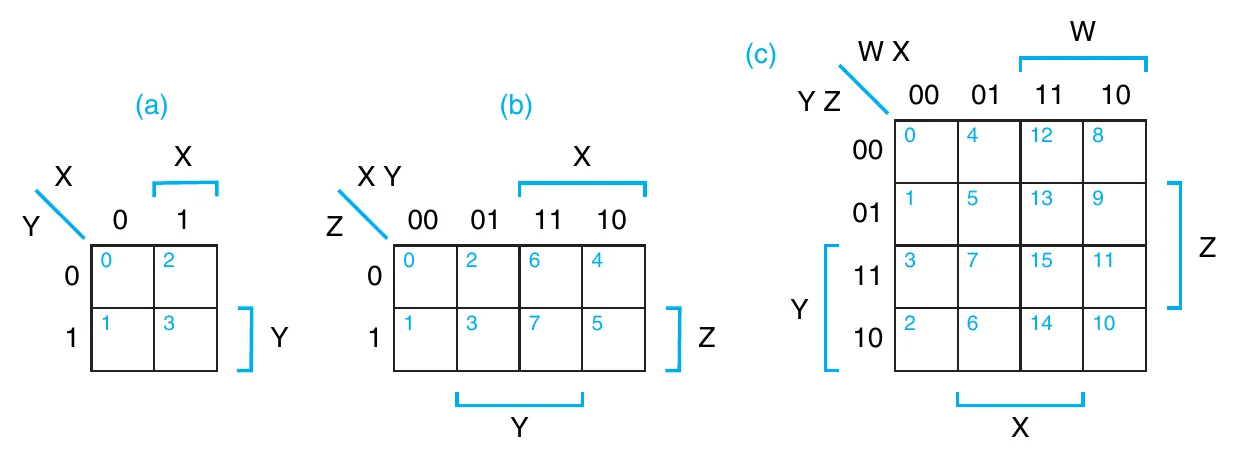DDPP5 第三章 “Switching Algebra and Combinational Logic” 的学习笔记。
本章的主要内容为逻辑代数、逻辑代数在电路中的使用及化简、timing hazard。
Switching Algebra
这一节基本上就是离散数学 (1) 开头两章的内容,术语和记号有很多不同,幸好忘的差不多了,不然都要搞混了。
记号
- AND:X ⋅ Y
- OR:X+Y
- NOT:X′
- AND 的优先级高于 OR
(yysy 我还是更喜欢 ∨,∧,⋅ 也还行,+ 真的有点难以接受。)(它们明明是对偶的怎么搞得像个环一样。)(主要还是下面这些定理用加号看起来真的好怪。)(异或不是还号称二进制加法吗。)
公理
(A1)(A1D)(A2)(A2D)(A3)(A3D)(A4)(A4D)(A5)(A5D)X=1⟹X=0X=0⟹X=1X=0⟹X′=1X=1⟹X′=00 ⋅ 0=01+1=11 ⋅ 1=10+0=00 ⋅ 1=1 ⋅ 0=01+0=0+1=1
定理
中文名来自《数理逻辑与集合论(第二版)》2.2 节“等值公式”。
(T1)(T1D)X+0=XX ⋅ 1=X(T2)(T2D)X+1=1X ⋅ 0=0(T3)(T3D)X+X=XX ⋅ X=X (T4)(X′)′=X(T5)(T5D)X+X′=1X ⋅ X′=0(T6)(T6D)X+Y=Y+XX ⋅ Y=Y ⋅ X(T7)(T7D)(X+Y)+Z=X+(Y+Z)(X ⋅ Y) ⋅ Z=X ⋅ (Y ⋅ Z)(T8)(T8D)X ⋅ (Y+Z)=X ⋅ Y+X ⋅ ZX+Y ⋅ Z=(X+Y) ⋅ (X+Z)(T9)(T9D)X+X ⋅ Y=XX ⋅ (X+Y)=X(T10)(T10D)X ⋅ Y+X ⋅ Y′=X(X+Y) ⋅ (X+Y′)=X(T11)(T11D)= X⋅Y+X′⋅Z+Y⋅ZX⋅Y+X′⋅Z= (X+Y)⋅(X′+Z)⋅(Y+Z)(X+Y)⋅(X′+Z)(T12)(T12D)X+X+⋯+X=XX ⋅ X ⋅ ⋯ ⋅ X=X(T13)(T13D)=(X ⋅ X ⋅ ⋯ ⋅ X)′X′+X′+⋯+X′=(X+X+⋯+X)′X′⋅ X′⋅ ⋯ ⋅ X′ (T14)=[F(X1,X2,…,Xn,+, ⋅ )]′ F(X1′,X2′,…,Xn′, ⋅ ,+)Identities(同一律)Null elements(零律)Idempotency(幂等律)Involution(双重否定律)Complements(补余律)Commutativity(交换律)Associativity(结合律)Distributivity(分配律)Covering(吸收律)CombiningConsensusGeneralized idempotencyDeMorgan’s theorem(摩根律)GeneralizedDeMorgan’s theorem
(T15)(T15D)Shannon’s expansion theoremsF(X1,X2,…,Xn)= X1 ⋅ F(1,X2,…,Xn)+X1′ ⋅ F(0,X2,…,Xn)F(X1,X2,…,Xn)=[X1+F(1,X2,…,Xn)]⋅[X1′+F(0,X2,…,Xn)]
(草,对齐好累,我为什么要浪费这个时间。)
Duality
将一个等式中所有的 0 换成 1、1 换成 0、+ 换成 ⋅、⋅ 换成 +,等式依然成立。
上面的定理中带 “D” 的都是上一条的对偶。
Standard Representations of Logic Functions
这里需要翻出来我离散 (1) 写的 真值表生成器(其实可以去加上 + 和 ⋅ 作为 alias,但如果要加 ′ 的话会很麻烦所以干脆不加了吧(
logic function 有若干精确的标准表示方法:
- 真值表
- canonical sum: 主析取范式,极小项 (minterm) 的和
- 使用 ∑ 表示的 minterm list
- canonical product: 主合取范式,极大项 (maxterm) 的和
- 使用 ∏ 表示的 maxterm list
- Verilog
case 语句
这里用 ∏ 表示 maxterm list 的下标比离散 (1) 讲的舒服多了:minterm 的 index 就是哪组变量取值下表达式值为 1,maxterm 的 index 就是哪组变量取值下表达式为 0,所以两种范式的下标刚好是补集。例如,有 X,Y,Z 三个变量,X′⋅Y⋅Z′ 的下标是 2,X′+Y+Z′ 的下标是 5;∑X,Y,Z(1,2,6)=X′⋅Y′⋅Z+X′⋅Y⋅Z′+X⋅Y⋅Z′=∏X,Y,Z(0,3,4,5,7)。
Verilog 的 case 语句大概是这个样子:(虽然还完全没学 Verilog,但我感觉 Shiki 自带的 system-verilog 高亮看起来就比 verilog 正确许多,以后可能也用 system-verilog 的高亮了)
case ({X,Y,Z})
1,2,6: F = 1;
default: F = 0;
endcase
case ({X,Y,Z})
1,2,6: F = 1;
default: F = 0;
endcase
Combinational-Circuit Analysis
这一节就是说给你一个电路图怎么搞出它的 logic function。其实没啥好说的,就(按拓扑序)一个一个 gate 递推就行,可以用真值表也可以用逻辑表达式。
有一个小 trick:DeMorgan’s theorem 在电路图中表现为,将 inversion bubble 换到另一侧(输入 / 输出),并且改变 gate 的类型(AND / OR),这样的话,如果两个 inversion bubble 在一条 wire 上就可以消掉。
Combinational-Circuit Synthesis
在 digital design 中,“Synthesis” 有若干种含义(例如从 HDL 到 FPGA),而在这一节只是指从 formal description 到 gate-level circuit。
Circuit Descriptions and Designs
自然语言描述 → 逻辑表达式 / 真值表(canonical sum / product) → 电路
很多时候写出逻辑表达式会比列出真值表简单一些,但在面对较为复杂的逻辑关系时,列出真值表可以强制设计师考虑到每种情况,从而避免漏掉 corner case。
一个输出是某个逻辑表达式的电路被称作 realize 了这个表达式,是这个表达式的 realization 或者 implementation。
Circuit Manipulations
在多数电路技术(包括 CMOS)中,NAND / NOR 比 AND / OR 效率更高,所以一般会修改电路来尽量使用 inverting gate 而非 noninverting gate:
- 在 wire 上移动 inversion bubble(从上一个输出移到下一个输入)
- 在 wire 的两侧同时加上 inversion bubble(或者 NOT gate)
- 消除同一根 wire 上的两个 inversion bubble
- 将 inversion bubble 换到另一侧(输入 / 输出),并且改变 gate 的类型(AND / OR)
Combinational-Circuit Minimization
一般情况下,逻辑表达式的化简主要用的是定理 T10(Combining),就是在 sum of products 中找到仅有一项相反的两个 product 将它们合并,最终得到的也是一个 sum of products,实现为 2-level(first-level 计算 product,second-level 计算 sum)的电路。
product of sums 电路是对偶的,就不重复了,下文也是一样。
Karnaugh Maps
如 DDPP5 Figure 3-23 所示:

在 Karnaugh map 中,每一个表示一个 minterm,相邻(包括跨过边界到另一侧的相邻)的格子仅有一位相反,所以边长为 1 / 2 / 4 的矩形可以合并。
选出若干矩形,恰好覆盖所有输出为 1 的格子,就可以化简逻辑表达式。
如果一个矩形覆盖的全是 1,并且是极大的(在其对应的 product 中减少任何一个输入都会使其覆盖到 0),就称作一个 prime implicant。最简的逻辑表达式是若干 prime implicant 的 sum。
有的函数的 Karnaugh map 非常分散(例如 parity function),没有连成一块的 1,就需要多级而非 2-level 的电路来进行化简。
在 FPGA 中,输入数量较少的电路都是通过 lookup table (LUT) 而非 gate-level circuit 来实现,只需真值表就可以。但复杂的电路需要由多个 LUT 组合起来,此时逻辑表达式的化简依然有用。
Timing Hazards
真实的电路中会有 delay,而上面研究的都是 combinational logic circuit 的 steady-state behavior,没有考虑到 transient behavior。
因为 delay 的存在,可能会发生这样的情况:输入发生了改变,稳态下的输出不变,但在一瞬间内输出发生了变化(产生了一个 short pulse)。这样的 pulse 被称作 glitch。
如果一个电路有产生 glitch 的可能性,则称这个电路存在 hazard。实际物理电路的 delay 大小等因素难以控制,所以这里只是考虑产生 glitch 的可能性,而非实际是否有 glitch 产生(有点类似于并发编程中要保证所有可能的执行顺序下都不出错)。
Static Hazards
static-1 hazard:稳态输出是 1,改变某一个输入后稳态输出还是 1,但这一个输入改变时可能会短暂地输出 0。static-0 hazard 是类似的。
书上给了个例子,但这个其实很好理解,就是电路的一个输入作为多个 gate 的输入,而这些 gate 的输出变化得有快有慢。
Finding Static Hazards Using Maps
正常的 sum of products 电路中不会有 static-0 hazard,可能有 static-1 hazard。
可以用 Karnaugh map 来找到 hazard:如果两个相邻的 1 没有被同一个 gate 覆盖,从其中一个变为另一个时就可能产生 glitch。(因为极端情况下可能所有覆盖原来那一格的 gate 先全部变为 0,覆盖后来那一格的 gate 才变为 1。)
消除 hazard 就是用冗余的 gate 来覆盖这样的相邻的 1,类似于定理 T11(Consensus)。
Dynamic Hazards
如果变化一个输入时可能产生不止一次 glitch,就称作 dynamic hazard。
一个正常的 2-level sum of products / product of sums 电路中不会有 dynamic hazard。
Designing Hazard-Free Circuits
在多数电路中(尤其是 synchronous digital system 中),hazard 不会造成什么影响。但在某些电路(asynchronous sequential circuits)中,需要避免 hazard 的存在。
在一般的电路中消除 hazard 是复杂的,而在 sum of products 中,可以用 Karnaugh map 或者取遍所有 prime implicant(称作 complete sum)来消除 hazard。
